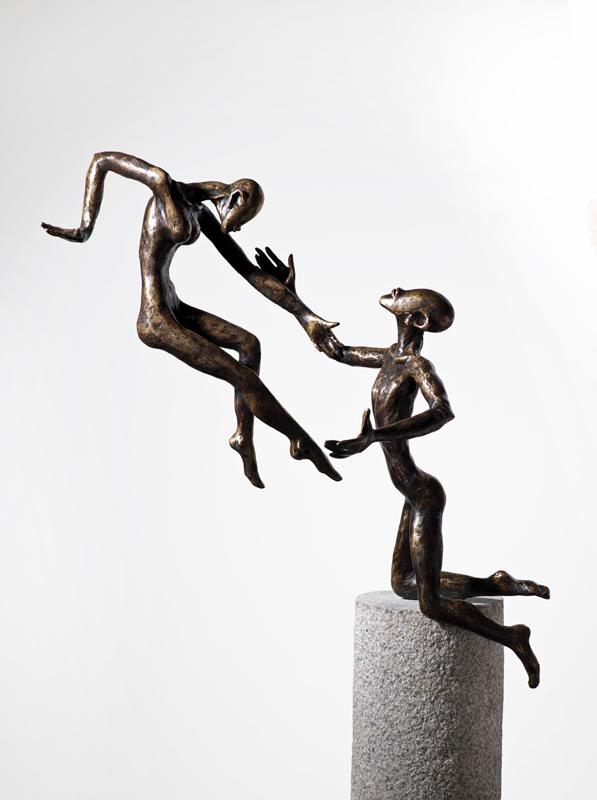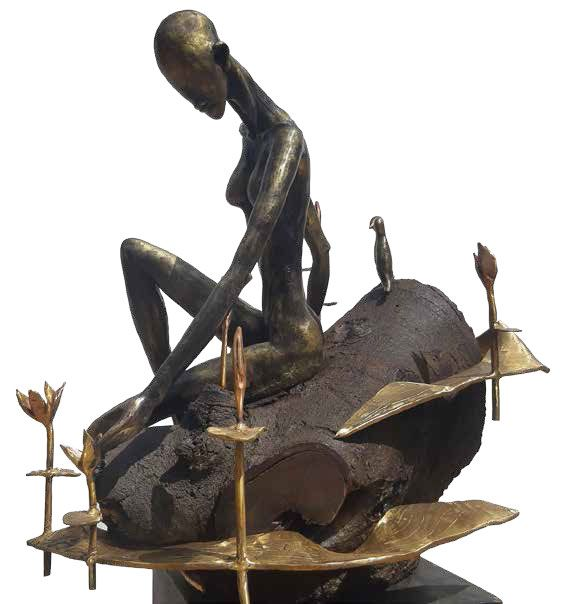Be it Ancient civilizations, Umberto Boccionis’ radical depiction of the modern man or Dimpy Menon’s uniquely transcendent pieces, the art of bronze sculpting has never lost its sheen.
Many people compare bronze less favourably to marble, associating it more with public monuments rather than fine art – that is, until they meet celebrated sculptor and artist Dimpy Menon. Her work encompasses a whole range of ‘bronze sculptures’, right from fluid statues and small figurines, to modern abstract pieces that bring alive public spaces.
“Some of our first known sculptures were cast in bronze. It is an ideal medium, versatile, rich in tone with an ability to achieve fine detail.” she begins, explaining that while the pandemic was testing the limits of human endurance, she was reimagining the world with her hands, working on a whole body of work commissioned by art lovers and collectors alike.
What makes Dimpy’s work instantly recognisable is the positivity and lightness of spirit each of her pieces carry, reflecting her philosophy to “seek light no matter how dense the darkness.” Currently in London, Dimpy is dividing her time between exhibitions, client meetings and a bit of much needed rest and recreation.
In the studio
One of her commissioned works for a collector in the US includes a 12-feet sculpture of a man, almost one with the sky. Another one for architect Hafiz Contractor in Kolkata depicts a figure on a park bench, savouring a lungful of unrestricted breeze. Responsive to the pandemic, the themes denote freedom from shackles, reaching for the sky and the stars, finding balance, repose and joy. The innate optimism and joie de vivre that Dimpy’s sculptures carry is also reflected in her home and personal lifestyle.
Whether it is a doodle on a living room wall, a splash of translucent paint across the window panes in her kitchen or a beautifully served Khow Suey meal with Ikea dinner napkins placed just so, her art and life are inextricably linked. In her studio dotted with sculptures in various stages of completion and in her home that overflows with sunshine and artifacts, plants and books, gentle conversations and self-sufficient silences, Dimpy demonstrates what it is to chisel an artistic and personal existence imbued with mindfulness and transcendent joy.
“I prefer to meditate upon life instead of constantly reacting to its ebb and flow,” she says. And she prefers quiet creativity over orchestrating a media chorus around her achievements. So even when she became the first Indian sculptor to win the Lorenzo il Magnifico Bronze award at the Florence Biennale in October 2015, she just rolled up her sleeves and carried on working.
“I have never measured success, but from time to time, I do stop to express gratitude for being able to work this way and for having the mental and physical strength to go on. I just feel lucky to be a “karmyogi” where the process itself is the reward. To be able to create joy is a gift I am most grateful for,” she adds.
Channeling hope and transcendent love
This is perhaps why she was chosen to create a bronze sculpture for the lobby of the Oberoi Hotel at Nariman Point, Mumbai post the terror attacks of 26/11. When the lobby reopened some 18 months after the attack, there it was. A seven-foot composition showing a couple reaching out to healing and freedom. The work was fittingly titled, ‘The Conversation,’ to represent the eternal dialogue humans-beings have with hope, empathy and transcendent love amid all the horror that they have to sometimes deal with. This piece in a way summed up what Dimpy’s art essentially is – a conversation with what lies within and beyond us.
That is why most of her sculptures float, leap, rise above restrictions, exude an all encompassing humanism and show us the futility of toxic fragmentation and division. Her sculptures freeze frame the ephemeral beauty of life that we miss when we look away in anger, when we judge, hate, dehumanise and reduce each other to mere labels. They say, “Why not just be ? Why not say a whole hearted, ‘Yes’ to human-existence? And rise together in harmony and synergy?”
Choosing upliftment
As she says, “ I choose not to reflect ugliness. I choose to say fulfilment is possible and aspiring to beauty, warmth, connection, triumph, harmony and balance is important. To project these ideals through my art is perhaps my Karma.”
Dimpy has never deviated from this path of telling uplifting stories through art. She graduated as a top ranking student from the Government College of Arts and Crafts, Chennai in 1986, majored in sculpture and went on to win the Lalit Kala State Award twice. She has remained prolific over the decades and today, her pieces adorn private collections and corporate spaces all over the world.
She says, “Every time someone commissions a work or spends money to buy a work, it is a great compliment. There are people who commission pieces for their loved ones, and that moves me immensely because I am memorialising a precious part of their life.” She also hopes one day sculptural pieces can become an intrinsic part of public spaces so people can communicate with them without the intervention of galleries and critics.
Roots of tradition, wings of freedom
Making life-sized sculptures is not easy and injuries and back-breaking work are a part of the process. But Dimpy remains resilient and reveals,
“Overtime, I have learnt to anticipate what can go wrong and have developed immense patience through this journey that takes me over eight to 10 weeks to finish a big sculpture. The most challenging part is the finishing process where I use power tools, files and chisels but as long I can, I will continue to create this way.”
Even during the lockdown, Dimpy continued to create and turned her garden into a makeshift studio. About her traditional technique, she says, “I draw from tradition because it has stood the test of time and I have great respect for it. I will not play around with the proportions of the human form nor with the technique used for the medium I work in. It would be like reinventing the wheel if I were to do that. But my artistic expression has evolved through experience. I know that all of my creative output comes from something that was done before. But still, every time I dig deeper, something new emerges. There are no shortcuts in art, you see.”
Art as a healing embrace
In a disjointed world, her work is like a healing embrace and a statement of faith in the fundamental goodness of human-beings. And this clearly matters to her because she says, “Art has been an integral part of my life since I was little and I will never cease to be thankful that I have the capacity to create hope and positivity. If art can help us to be sensitive to one another and stay attuned to the emotions like empathy, what more can you ask of it?”
She continues, “Art done with a certain intentionality also shows how important it is to nurture inner strength. If art can transport us to an ideal place in the mind and help us transcend the negativity of the here and now, it has done its job. I hope that what I create communicates this spirit. The purpose of my work is that while it eternalises my ideas, it gives someone the opportunity to experience life in a different way. Hopefully it transports them to another realm. And that is why art is life itself for me.”
Text by Jackie Pinto
Photographs via Dimpy Menon













